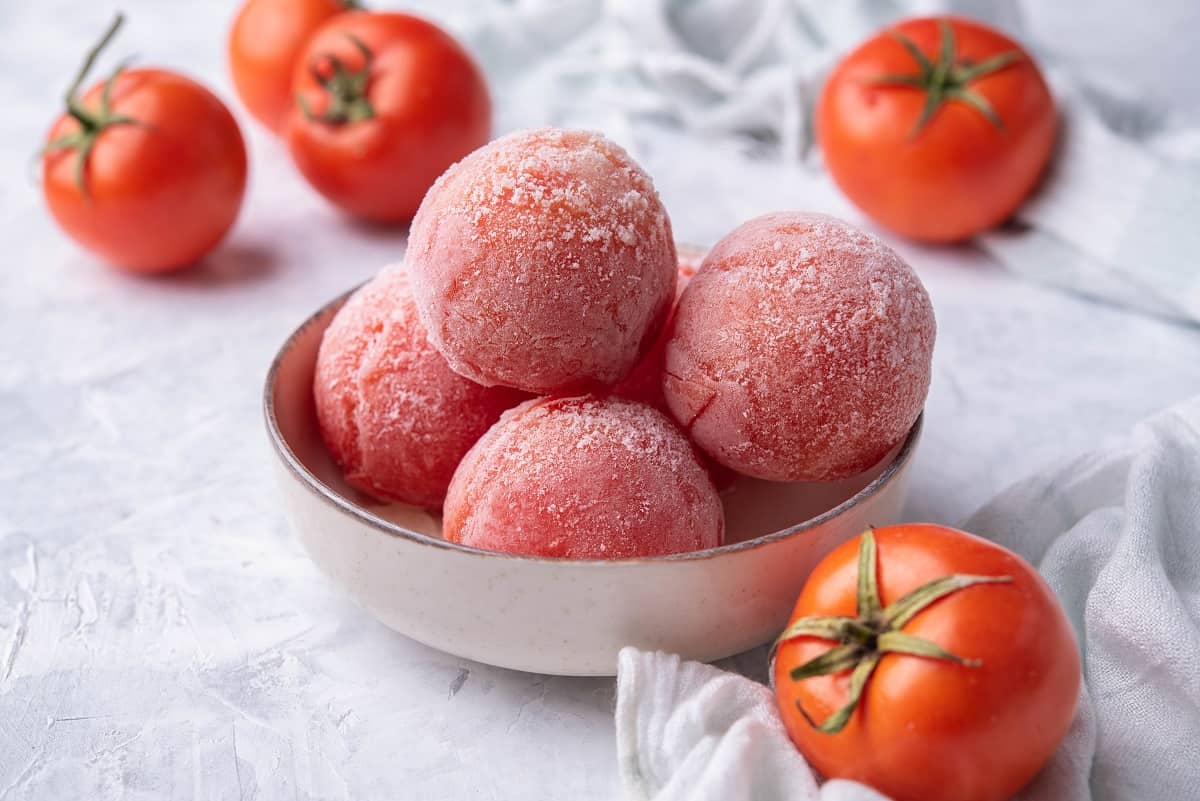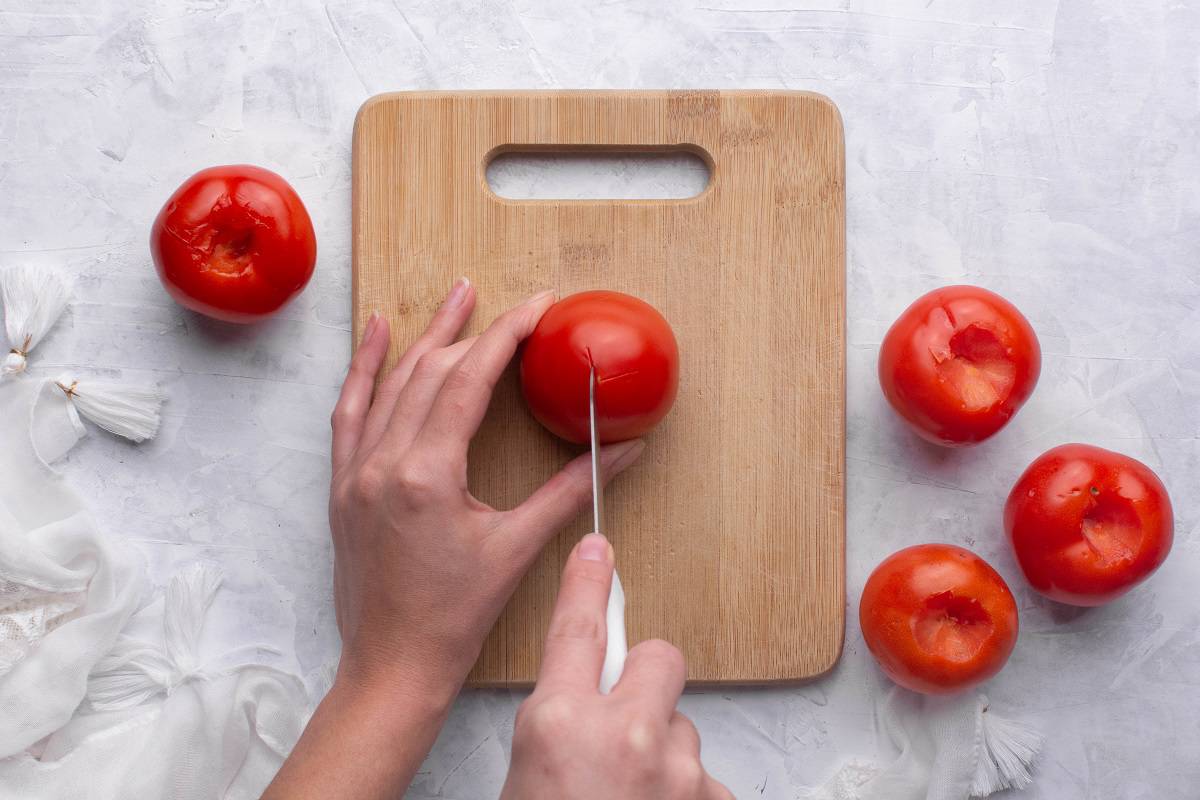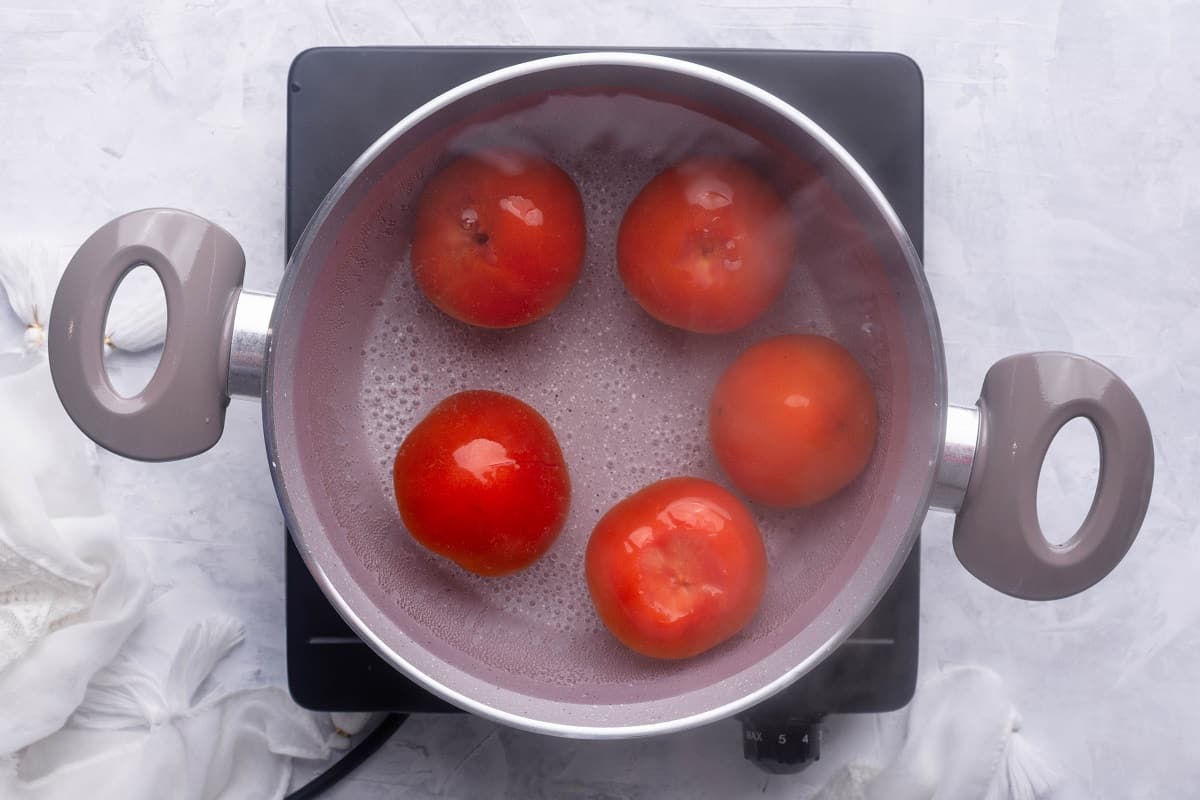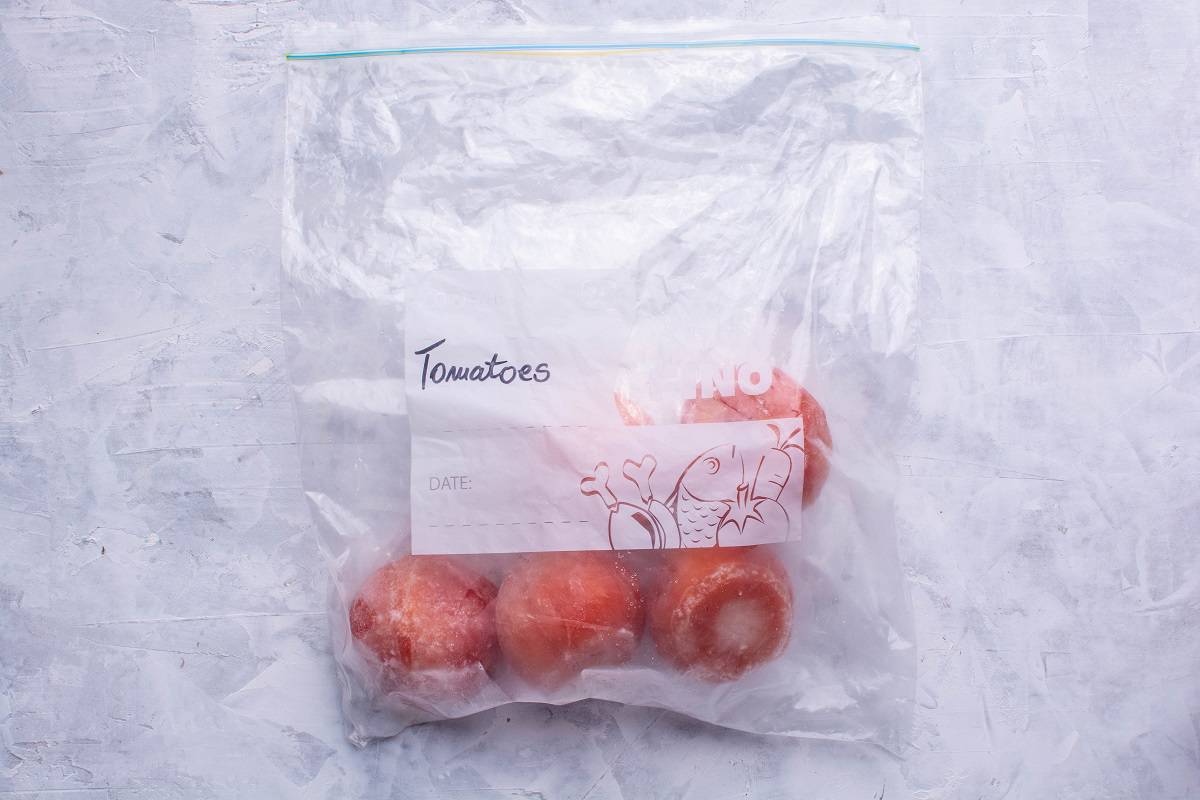The advent of the tomato season in any tomato growing region is a big The Deal Whether you grow them yourself, raid the local farmer’s market to collect as many baskets as you can, or stock up at your favorite supermarket whenever you get a chance–there’s never such a thing as too many juicy tomatoes!
It’s never a bad idea to score as many of these sweet but deliciously tart fruits as you can, however, leaving you scratching your head about what to do with them. Home canning used to be the main — and extremely time-consuming — method for preserving tomatoes, now there’s another way to extend the life of your ruby red treasures.
We walk you through how to freeze fresh tomatoes. Spoiler alert: it’s so easy you’re just a few easy steps away from getting your tomato stash safely in the freezer for long-term storage!
Ingredients and equipment needed for freezing tomatoes

Fortunately, you don’t need any fancy supplies or special equipment to prepare your ripe tomatoes for long periods in the freezer. Just a few common kitchen items will do the trick!
Ripe fresh tomatoes
First and foremost, let’s talk about those tomatoes. The freezing method described below is recommended only for ripe, large, whole tomatoes such as beefsteak tomatoes, garden tomatoes, and plum/paste tomatoes.
Ripe or green tomatoes will not work well here, nor will small cherry tomatoes or those that have already been cut or chopped. We do not recommend using this method to freeze stewed tomatoes or anything that has been otherwise cooked.
Be careful not to spoil your tomatoes very Ripe, as too much spice separates during the tomato blanching and freezing process. And if your tomatoes are rotting or have some dark spots, it’s best not to freeze them because they’ll get worse the longer they hang around.
Pruning knife
It may be the smaller knife you feel most comfortable working with. Smaller and more efficient knives can be most useful in these situations, and you’ll find that a small bird’s beak or serrated knife is particularly helpful here.
big pot
Depending on how many tomatoes you’re aiming to freeze, you’ll probably want to reach for your largest soup pot or stock pot to help you with this task. You want to be sure that the tomatoes can be completely submerged in the water without crowding.
Cable rack (optional)
A wire rack can be useful if it’s time to cool your tomatoes before peeling them, but it’s not necessary. If you have one, go ahead and bring it out!
A sheet used for baking something
You’ll be freezing your tomatoes directly on a baking sheet, so the key here is to choose a pan that will fit flat in your freezer. If this is not an option for you, choose a small freezer safe dish or plate.
Parchment paper
We like to use parchment to keep the frozen tomatoes from sticking to the sheet pan, but you can also use wax paper here, even a layer of plastic wrap will do the trick! We do not recommend using aluminum foil in this case as it may react with the acidity of the tomatoes and cause an odd color and/or smell.
Freezer-friendly storage containers
You’ll need some airtight container for long-term storage of your frozen tomatoes, but it’s up to you whether you prefer freezer bags, freezer-safe Tupperware style containers, or another option.
The main thing to remember is to choose one airtight Containers that keep your products safe from freezer burn and also work well for your specific freezer space and shape limitations. Read more about different freezer-friendly storage containers in our guide Containers for frozen food!
A step-by-step guide to freezing whole tomatoes
Freezing fresh tomatoes is easy, requiring only 8 simple steps.
Step 1: Wash the tomatoes

Whether you get it at the farmer’s market or the grocery store, it’s always a good idea to wash your produce. When you plan to freeze fresh produce, this is even more important because you don’t want any lingering bacteria or contaminants to enter your freezer!
Simply run your ripe tomatoes under cool running water and gently scrub with your hands, or, break out your favorite fruit and veggie wash.
Step 2: Core the tomatoes

Use your paring knife to remove the stem and core from each tomato. If there are other spots or if there are wood spots on the opposite side of the tomato, go ahead and remove these areas as well.
Step 3: Score the tomatoes

Using your paring knife, score the bottom (opposite end of the stem) with an “X” mark. You don’t want to cut too deep here, the idea is to get through the outer skin and just into the surface flesh. This will help you remove the skin when the time comes.
Step 4: Blanch the tomatoes

Fill your large pot with water and bring it to a boil over medium-high heat. Add the tomatoes to the water and boil briefly – about 30-40 seconds should do it. When you blanch tomatoes, you want to be sure to keep the water on medium heat because rapidly boiling water will be very rough on this tender fruit.
Also, depending on the size of your pot and how many tomatoes you’re working with, you may need to blanch a few tomatoes at a time. It is very important that each batch of tomatoes has plenty of room to swim around and take an equal share of the heat!
Step 5: Peel the tomatoes

Using a slotted spoon, remove the tomatoes from the hot water and place them where they can cool – either on a wire rack, if you have one, or a clean kitchen towel. If you want to speed up the cooling process, you can give each tomato a brief dip in a bowl of ice water.
When cool enough to handle, begin by making an “X” mark on each tomato and peel the tomatoes. They should slide off fairly easily, but don’t hesitate to use a paring knife to assist if necessary.
Step 6: Slice and freeze the tomatoes

Line a baking sheet with parchment paper (or wax paper or plastic wrap, as discussed above) and arrange the peeled tomatoes in a single layer. You want to make sure the tomatoes have enough space and aren’t touching each other.
Place the baking sheet of tomatoes on a flat surface in your freezer where they can remain undisturbed for about 4 hours or until frozen solid.
Step 7: Repackage the tomatoes

Once frozen, remove the tomatoes from the baking sheet and repackage them in a long-term storage container. We recommend using a freezer bag, as this tends to be the most compact option. Be sure to remove as much air as possible from the bag before sealing, as this will help protect the tomatoes from freezer burn.
If you want to use a hard-sided freezer-safe storage container, that works perfectly too! It’s all about your personal preferences as well as the best use of your freezer room.
Step 8: Preserve the Tomatoes

Label and date your packages of frozen tomatoes and transfer them to your freezer for long-term storage. When properly prepared and packaged, your frozen tomatoes will last about 6 months!
How to Thaw Frozen Tomatoes
Method 1: Don’t!
In many cases, you don’t necessarily have to thaw your frozen tomatoes before using them! If you’re using them to make a sauce or soup that will be cooked for a long time or pureed at the end, you can throw whole frozen tomatoes into the dish, as they’ll have plenty of time to thaw and break down. presence of heat.
Method 2: Refrigerate overnight
If you want your tomatoes to thaw completely, the best way to do this is to transfer them from the freezer to the refrigerator the night before using them. This allows frozen tomatoes to defrost slowly and safely with minimal effort on your part!
Method 3: Fast in water
If you want to get your frozen tomatoes ready for use sooner, you can speed up the thawing process by placing them in a freezer bag (if they aren’t already) and submerging the bag in a large bowl of lukewarm water.
You can leave this setup at room temperature until the tomatoes begin to soften, changing the water as often as needed.
Note that it is important to keep tomatoes in a sealed bag as opposed to directly in water. Doing so will cause them to become waterlogged, thereby diluting their precious flavor!
Freezing Tomatoes FAQs
Can you freeze tomatoes without blanching?
While we definitely recommend blanching and peeling the tomatoes before freezing, you can skip this step if you’re short on time. Once the frozen tomatoes are defrosted, you will have the opportunity to peel them as well. Or, if you don’t mind a few tomato skins in your soup or sauce, leave them out!
Do you remove the seeds when storing tomatoes?
You’ll notice we didn’t mention removing those tomato seeds before freezing. This is because to seed a tomato, you must pluck it, and tomatoes freeze best intact.
If you want to remove the seeds before cooking with your tomatoes, run them through a food mill after you defrost them.
Does freezing tomatoes destroy them?
No way! Frozen tomatoes certainly differ from fresh ones in terms of texture as well as taste, but this does not spoil them in any way.
Eating frozen tomatoes raw won’t be as enjoyable as biting into slices of fresh tomatoes, but there are plenty of ways to make delicious flavor out of your frozen tomatoes.
Ideas for using frozen tomatoes
While the texture of pre-frozen tomatoes makes them a poor choice for slicing on a sandwich, there are plenty of delicious ways to enjoy the fruits of your frozen labor! From soups and stews to homemade tomato sauce, here are a few ideas for using up your batch of frozen tomatoes.
- Try frozen tomatoes in a slow cooker soup, as the long simmering time means any problems with an unpleasant texture will be a moot point! our Slow Cooker Lentil Veggie Soup The recipe calls for canned diced tomatoes, but your own frozen tomatoes are even better. Defrost the tomatoes enough to roughly chop and add to the other ingredients.
- Frozen tomatoes are great when mixed with your ribs from the stick Red river rice or Skillet Potatoes with Lentils. Defrost just enough to chop, then use in place of tomatoes when called for.
- No, you don’t have to stand over the stove all day to make homemade red sauce! this Slow Cooker Spaghetti Sauce A great way to honor the rich flavor of those perfectly ripe tomatoes you’ve worked so hard to preserve.
Final thoughts on freezing tomatoes
As you can see, it’s pretty easy to store tomatoes until you don’t have time to deal with them or until that mid-winter mood hits you for a summer blast! As long as your tomatoes are nicely ripe and in good shape, they will keep well in the freezer and are a very versatile staple to have on hand once defrosted.
The next time you have a pile of fresh tomatoes, feel free to save the sauce-making for another day. With just a few kitchen items and a little time, your tomatoes will be safely packed and ready for you whenever you ready for their.

printed
pin
How to freeze tomatoes
material
- Fresh ripe tomatoes caught

